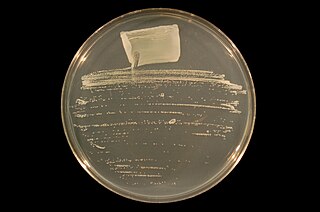
Thermus is a genus of thermophilic bacteria. It is one of several bacteria belonging to the Deinococcota phylum. According to comparative analysis of 16S rRNA, this is one the most ancient group of bacteria Thermus species can be distinguished from other genera in the family Thermaceae as well as all other bacteria by the presence of eight conserved signature indels found in proteins such as adenylate kinase and replicative DNA helicase as well as 14 conserved signature proteins that are exclusively shared by members of this genus.

Ensifer is a genus of nitrogen-fixing bacteria (rhizobia), three of which have been sequenced.
Pluralibacter gergoviae is a Gram-negative, motile, facultatively-anaerobic, rod-shaped bacterium. P. gergoviae is of special interest to the cosmetics industry, as it displays resistance to parabens, a common antimicrobial agent added to cosmetic products.
Faecalibacterium is a genus of bacteria. The genus contains several species including Faecalibacterium prausnitzii, Faecalibacterium butyricigenerans, Faecalibacterium longum, Faecalibacterium duncaniae, Faecalibacterium hattorii, and Faecalibacterium gallinarum. Its first known species, Faecalibacterium prausnitzii is gram-positive, mesophilic, rod-shaped, and anaerobic, and is one of the most abundant and important commensal bacteria of the human gut microbiota. It is non-spore forming and non-motile. These bacteria produce butyrate and other short-chain fatty acids through the fermentation of dietary fiber. The production of butyrate makes them an important member of the gut microbiota, fighting against inflammation.

Streptomyces griseus is a species of bacteria in the genus Streptomyces commonly found in soil. A few strains have been also reported from deep-sea sediments. It is a Gram-positive bacterium with high GC content. Along with most other streptomycetes, S. griseus strains are well known producers of antibiotics and other such commercially significant secondary metabolites. These strains are known to be producers of 32 different structural types of bioactive compounds. Streptomycin, the first antibiotic ever reported from a bacterium, comes from strains of S. griseus. Recently, the whole genome sequence of one of its strains had been completed.
Bradyrhizobium arachidis is a species of legume-root nodulating, microsymbiotic nitrogen-fixing bacterium. It was first isolated from Arachis hypogaea root nodules in China. Its type strain is CCBAU 051107T.
Streptomyces chlorus is a bacterium species from the genus of Streptomyces which has been isolated from hay meadow soil from the Cockle Park Experimental Farm in Northumberland in the United Kingdom.
Streptomyces incanus is a bacterium species from the genus of Streptomyces which has been isolated from soil of a hay meadow from the Cockle Park Experimental Farm in Northumberland in the United Kingdom.
Streptomyces pharetrae is a bacterium species from the genus of Streptomyces which has been isolated from soil from the Western Cape Province in South Africa.
Streptomyces pratens is a bacterium species from the genus of Streptomyces which has been isolated from soil from a hay meadow.
Streptomyces vietnamensis is a bacterium species from the genus of Streptomyces which has been isolated from forest soil in Vietnam.
Streptomyces viridis is a bacterium species from the genus of Streptomyces which has been isolated from soil from a hay meadow.
Streptomyces xinghaiensis is a bacterium species from the genus of Streptomyces which has been isolated from marine sediments from Xinghai Bay near Dalian in China.
Microbacterium marinum is a Gram-positive and rod-shaped bacterium from the genus Microbacterium which has been isolated from seawater from the South-West Indian Ocean.
Paraburkholderia is a genus of Pseudomonadota that are gram negative, slightly curved rods that are motile by means of flagella. They have been reported to colonize endophytic tissues of hybrid spruce and lodgepole pine with a strong potential to perform biological nitrogen fixation and plant growth promotion. Unlike Burkholderia species, Paraburkholderia members are not commonly associated with human infection. Paraburkholderia members form a monophyletic clade within the Burkholderiaceae family, which is what prompted their distinction as a genus independent from Burkholderia species, in combination with the finding of robust conserved signature indels which are unique to Paraburkholderia species, and are lacking in members of the genus Burkholderia. These CSIs distinguish the genus from all other bacteria. Additionally, the CSIs that were found to be shared by Burkholderia species are absent in Paraburkholderia, providing evidence of separate lineages.
Streptomyces alkaliterrae is a bacterium species from the genus Streptomyces which has been isolated from alkaline soil.
Pluralibacter is a genus of Gram negative bacteria from the family of Enterobacteriaceae. The genus consists of two species, P. gergoviae and P. pyrinus. Both species were originally classified in the genus Enterobacter but were reclassified into the novel genus Pluralibacter in 2013.
Pluralibacter pyrinus is a Gram-negative, motile, facultatively-anaerobic, rod-shaped bacterium. P. pyrinus is the causitive agent of brown leaf spot disease of pear trees.
Labedella phragmitis is a Gram-positive, rod-shaped, non-spore-forming, aerobic and non-motile bacterium from the genus Labedella which has been isolated from the surface of a plant from the Taklamakan Desert.
Pseudocitrobacter is a genus of gram-negative, facultatively anaerobic, rob-shaped, non-homolytic, and oxidase-negative cells first found in stool samples from a Pakistani hospital.


